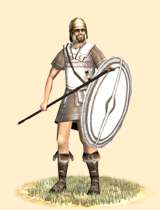Misthophoroi Iphikratous Hoplitai (Mercenary Greek Hoplite Phalanx)
 |
Weapons | Defence | Mental | ||||||
|---|---|---|---|---|---|---|---|---|---|
| Primary | Secondary | Armour: | 8 | Morale: | 11 | ||||
| Type: | spear | sword | Shield: | 3 | Discipline: | normal | |||
| Attack: | 14 | 10 | Skill: | 8 | Training: | highly_trained | |||
| Charge: | 6 | 6 | Recruitment | Other | |||||
| Lethality: | 0.13 | 0.13 | Soldiers: | 40 | Hit Points: | 1 | |||
| Range: | 0 | 0 | Cost: | 1275 | Mass: | 1.2 | |||
| Ammo: | 0 | 0 | Upkeep: | 319 | |||||
| Turns: | 1 | ||||||||

Misthophoroi Iphikratous Hoplitai are mercenary phalanx spearmen who are most effective in the formidable, if slightly inflexible, phalanx formation.
Hardy
Sapping Ability
The hoplite went through a technological revolution from the time of the Peloponnesian wars right up until about 250 B.C. Gone were the old hoplon and metal cuirass, gone was the short spears and crested helmets. These mercenaries that sell their services all across the Mediterranean were equipped with the latest in Greek technical innovation. Longer spears, linen armor, lighter shields, boots, and Attic style helmets were the order of the day. This equipment put the hoplite on a par with his Macedonian rival and made him lighter and quicker. These men are the quintessential heavy spear phalanx, and should be utilized in such a fashion. They are mobile and less tactically rigid than their Macedonian counterpart (whose primary job is to tie up the enemy infantry). They’re hard hitting and well able to engage in melee with their blades if the phalanx is disrupted. They’re still vulnerable to flanking attacks and to missile troops, but are on a par with the Hellenistic troops as a unit.
Historically, the reforms of Iphikrates are the most notable in the series of innovations that befell the Greeks, hence the name of the Hoplite. They were still able to trounce just about anyone with equal numbers (which they almost never had). During the long series of internecine squabbles with Hellenistic powers and one another, the Greek cities had a great deal of trouble dealing with enemy mobile troops. This is offset somewhat by their equipment. Iphikrates himself can be reasonably credited with the adoption of a smaller shield, a longer spear, a better sword, and lighter armor. The helmet came later, around 350 B.C., followed by a further lengthening of the spear and adoption of the small thureos after the Galatian incursions. Boots were adopted by the Greeks around 300 B.C. and the final lengthening of the spear (to better fight Macedonians) happened near 280 B.C. Numbers of individual armies dwindled due to infighting and constant mercenary activity.